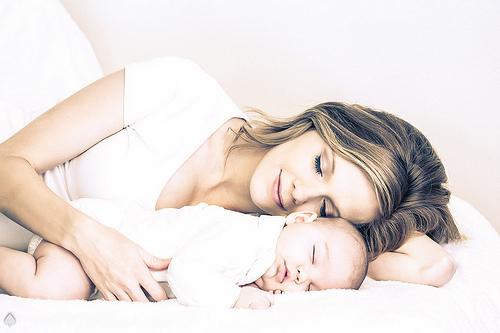Why I Chose to Co-Sleep
When I got pregnant with our first child in 2009, I wasn't totally knowledgable about natural parenting. I knew that I wanted a natural birth, that I wanted to breastfeed, and that - eventually - I wanted to cloth diaper. That's about it. Our plans for sleeping arrangements were to set up a bassinette in our bedroom for the first few months of Maya's life, then to move her to a crib in her own room. Well.... things did not quite work out that way. We did start out with a bassinette in our bedroom. I stayed up for most of the night... every night... listening for any and every sound coming from that babe's mouth. Every whimper, sigh, hiccup that escaped her sweet little lips sent me scrambling over in a sleep-deprived haze to make sure something terrible wasn't happening. And then of course, if I did manage to doze off for thirty minutes or so, I was awakened shortly after because she needed to nurse. In addition to getting up to nurse, Maya was a fairly high-needs baby. She wanted to be held almost constantly. She wanted to nurse every 30 - 45 minutes it seemed, and it lasted for months. After she turned three months, she could no longer fit into her bassinette, so we disassembled her crib (the one waiting for her in "her own room") and moved it into our tiny bedroom, right up against my side of the bed. "This is a great idea!" I thought. "Now she can be close to me, and I won't have to walk across the room to nurse! This will make things so much easier!" Wrong again. She had a very hard time sleeping, and would wake up crying at all hours of the night. She was inconsolable unless she was in my arms. She wasn't sleeping... my husband wasn't sleeping... and I definitely wasn't sleeping. Then one night, in a fit of frustration from constant nursing and lack of adequate rest, I exclaimed "I'm putting her into bed with me! I HAVE to sleep!!" My husband was very concerned about this, as he was terrified of rolling over on her. I understood, because I was afraid of that too, but something told me it would be okay. And oh my stars, it was more than okay! She slept!! And my husband slept (well, after he realized he wasn't going to roll over on her)!! And I slept, too!! When she woke to nurse, I was already right there. Whenever I felt her stirring I immediately woke up to see what her needs were, then went right back to sleep. It is a common misconception that co-sleeping is a dangerous practice, but the truth is, for healthy parents who do not smoke, use sedatives, drugs, or certain other medications, and who are not hard to waken, co-sleeping is a natural and safe practice that benefits both the baby and breastfeeding mothers! Probably one of the most interesting and important benefits of co-sleeping is that it greatly reduces the risk of SIDS. This is thought to be so because there is a synchronicity involved in mothers and their babies when sleeping beside one another. Babies tend to naturally sleep on their backs or sides moreso than their stomachs, which has been one theorized component of SIDS cases. In addition, the breath, arousability, and waking patterns of mother and baby seem to sync up while co-sleeping. If the theory that SIDS is a disorder in which a baby is difficult to waken when something causes breathing to cease, then it makes perfect sense that the stimulation of mother's breath, along with increased arousability and proper sleep positioning could drastically reduce the chances of SIDS death. Babies who co-sleep feel safe and comforted day and night since they are so close to their parents, which offers a sense of security that often results in less dependency during the day. Knowing that your baby is safe and restful beside you can help you and/or your partner relax and get a much higher quality of rest. While discussing the benefits of co-sleeping are important, there is also the question of how to co-sleep. Many parents are comfortable keeping their babies in bed beside them, but some parents may be too nervous or dislike the idea of baby being right there in the same bed. In this instance, something like the Arm's Reach Co-Sleeper (link: https://www.armsreach.com/shop) may be a more comfortable solution. This is basically a crib with a lowering side that attaches directly to your mattress. This allows you to have your baby at "arm's reach," but without baby being directly in your bed. If you want baby in bed with you, but are nervous about him/her falling off of the bed, products like the Tres Tria Natural Co Sleeper Pillow (link: http://www.babyecotrends.com/item/Tres_Tria_Natural_Co_Sleeper_Pillow/1587) can help put your mind at ease by acting as a "bumper" to prevent accidents from happening. A more economical approach could be to use a First Years Secure Sleeper, which fits right into bed with you, but prevents accidental rolling. (link: http://www.amazon.com/The-First-Years-Secure-Sleeper/dp/B00012CHFI) To understand the science behind co-sleeping's effects on babies and their caregivers, Dr. Sears has written an intelligent and highly-informative article that I would encourage anyone who is considering co-sleeping to read. This article can be found via the following link: http://www.askdrsears.com/topics/health-concerns/sleep-problems/co-sleeping-yes-no-sometimes Co-sleeping isn't for everyone, and you have to trust your intuition when making the decision as to whether or not it is the right choice for you and your baby, but hopefully this information, and the information found on Dr. Sears' website can help you make the most knowledgable decision. Do you co-sleep? What does co-sleeping look like for you and your baby? ~ Lindsay Lewis


